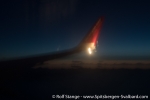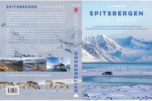-
current
recommendations- Liefdefjord
New page dedicated to one of Spitsbergen's most beautiful fjords. Background information and many photos.
- New Spitsbergen guidebook
The new edition of my Spitsbergen guidebook is out and available now!
- Liefdefjord
New page dedicated to one of Spitsbergen's most beautiful fjords. Background information and many photos.
Page Structure
-
Spitsbergen-News
- Select Month
- June 2025
- May 2025
- April 2025
- March 2025
- February 2025
- January 2025
- December 2024
- November 2024
- October 2024
- September 2024
- August 2024
- July 2024
- June 2024
- May 2024
- April 2024
- March 2024
- February 2024
- January 2024
- December 2023
- November 2023
- October 2023
- September 2023
- August 2023
- July 2023
- June 2023
- May 2023
- April 2023
- March 2023
- February 2023
- January 2023
- December 2022
- November 2022
- October 2022
- September 2022
- August 2022
- July 2022
- June 2022
- May 2022
- April 2022
- March 2022
- February 2022
- January 2022
- December 2021
- November 2021
- October 2021
- September 2021
- August 2021
- July 2021
- June 2021
- May 2021
- April 2021
- March 2021
- February 2021
- January 2021
- December 2020
- November 2020
- October 2020
- September 2020
- August 2020
- July 2020
- June 2020
- May 2020
- April 2020
- March 2020
- February 2020
- January 2020
- December 2019
- November 2019
- October 2019
- September 2019
- August 2019
- July 2019
- June 2019
- May 2019
- April 2019
- March 2019
- February 2019
- January 2019
- December 2018
- November 2018
- October 2018
- September 2018
- August 2018
- July 2018
- June 2018
- May 2018
- April 2018
- March 2018
- February 2018
- January 2018
- December 2017
- November 2017
- October 2017
- September 2017
- August 2017
- July 2017
- June 2017
- May 2017
- April 2017
- March 2017
- February 2017
- January 2017
- December 2016
- November 2016
- October 2016
- September 2016
- August 2016
- July 2016
- June 2016
- May 2016
- April 2016
- March 2016
- February 2016
- January 2016
- December 2015
- November 2015
- October 2015
- September 2015
- August 2015
- July 2015
- June 2015
- May 2015
- April 2015
- March 2015
- February 2015
- January 2015
- December 2014
- November 2014
- October 2014
- September 2014
- August 2014
- July 2014
- June 2014
- May 2014
- April 2014
- March 2014
- February 2014
- January 2014
- December 2013
- November 2013
- October 2013
- September 2013
- August 2013
- July 2013
- June 2013
- May 2013
- April 2013
- March 2013
- February 2013
- January 2013
- December 2012
- November 2012
- October 2012
- September 2012
- August 2012
- July 2012
- June 2012
- May 2012
- April 2012
- March 2012
- February 2012
- January 2012
- December 2011
- November 2011
- October 2011
- September 2011
- August 2011
- May 2011
- April 2011
- March 2011
- February 2011
- January 2011
- December 2010
- November 2010
- September 2010
- August 2010
- July 2010
- June 2010
- May 2010
- April 2010
- March 2010
- February 2010
- November 2009
- October 2009
- August 2009
- July 2009
- June 2009
- May 2009
- April 2009
- March 2009
- February 2009
- January 2009
- December 2008
- November 2008
- October 2008
- August 2008
- July 2008
- June 2008
- May 2008
- April 2008
- March 2008
- February 2008
- April 2000
- Select Month
-
weather information
-
Newsletter

| Guidebook: Spitsbergen-Svalbard |
Home
→
Yearly Archives: 2019 − Travelblog
Vinkelstasjon, neighbour reindeer and Science Slam
Sun
20 Jan
2019
Time is flying, there is always something to do. Mostly stuff that isn’t worth mentioning, but it is really filling the days. Everyday life. Projects. Work.
Yes, and life. Friends. Being outside.
Being outside is obviously one main reason for living in Longyearbyen. It will soon be full moon and the sky is mostly clear. The light is pure magic. The Norwegians have a beautiful word for that: “trolsk”. Maybe you can use “trollish” to translate it? It is “magical”, but that does not really hit the nail on the head. With “trolsk”, we don’t associate Harry Potter but rather some kind of fairytale magic with a slight undertone of danger and gloominess. Just like the arctic: of breathtaking beauty, but with a touch of danger lurking somewhere hidden, often not being visible. Trolsk.
Most tours do currently not go anywhere remote. That is not the point now. You will find the whole beauty of the polar night in Longyearbyen’s vicinity. It is of course always an idea to go somewhere without artificial light.
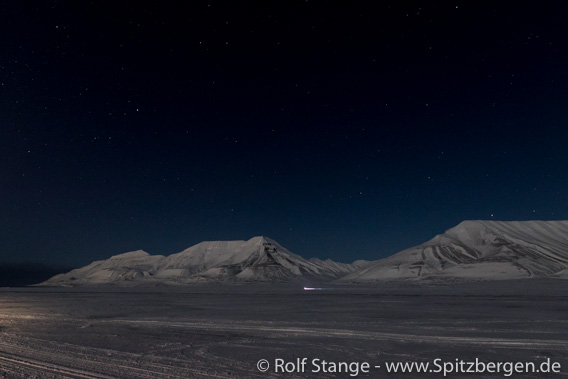
Adventdalen in the polar night.
There is, of course, a lot of artificial light in and near Longyearbyen. Whenever there is a northern light you have to go to a suitable place for undisturbed observation and photography. A bit of artificial light does, of course, not hurt, often it has a charme of its own. Like the Vinkelstasjon in Endalen, which used to be a part of the old coal cableway. Today, it is illuminated during the polar night, providing a lovely eyecatcher in the dark landscape.
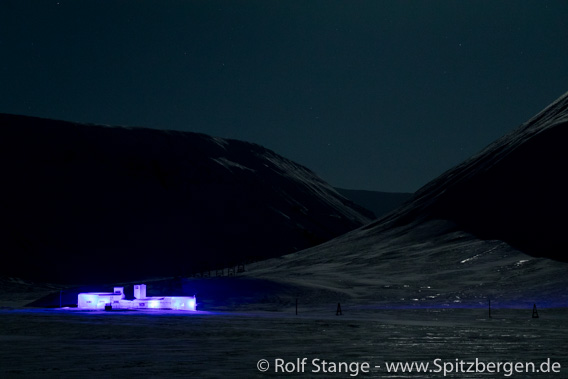
The Vinkelstasjon in Endalen used to be a part of the coal cableway in the past.
Today, it is part of the local history and, in the dark time, a light installation.
It is part of the practical aspects of moving around in the dark that high-vis jackets and reflectors are strongly advised. Otherwise, the risk of being hit by a car is significant and one day it will crash.
The reindeer don’t know that. They tend to stand just next to the road. And the don’t look left or right before they start crossing it.
When you leave the house in the morning and there is a reindeer next to the entrance in the dark, then it can give you a bit of a sudden weak-up. As soon as you realise that the big furry animal just in front of you is actually a reindeer, it is a bit of a relief which feels quite good.
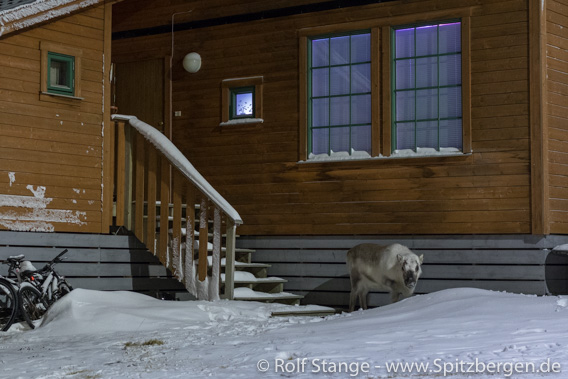
Reindeer in Longyearbyen.
There is a lot going on in Longyearbyen in terms of culture, education and science. In January, there is the Svalbardseminar. Experts of various fields offer presentations to tell the public about their field of knowledge. These presentations are usually in Norwegian, hence not an attraction for international visitors, but if you understand Norwegian, then they are usually very interesting.
This week, there was a “Science Slam” scheduled. Several scientists talked about their work and research results in short lectures which were supposed to be as entertaining as educative. Everything was allowed as long as it is not generally forbidden and nobody is harmed. This worked altogether quite well.
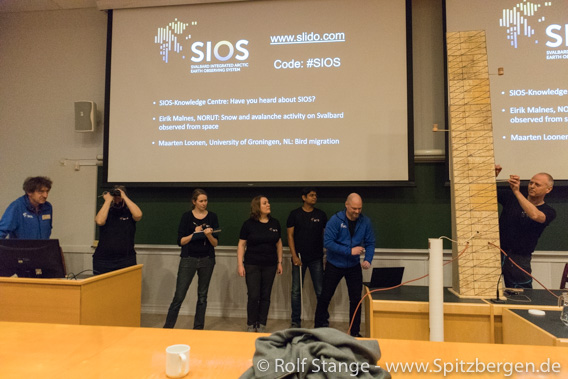
SIOS Svalbard introducing themselves in the Svalbardseminar at UNIS.
In the photo above, SIOS Svalbard (“Svalbard integrated arctic earth observing system”) staff are introducing their organisation, the design and purpose of which is hard to grasp in just a few words. SIOS is kind of a meta-scientific organisation, trying to ensure that efficient collecting and exchange of all sorts of data is working smoothly in practice, beyond borders of different nationalities, projects and fields of science.
And then, there is of course Maarten Loonen, the Dutch specialist for bird migration, arctic geese and tundra. We meet him quite regularly in Ny-Ålesund in the summer, where he has been part of the regular outfit as long as even the oldest ones can remember. In a way that you just can’t imitate, Maarten manages to squeeze a lot of knowledge into a few minutes that is hard to remember – unfortunately, because it is fascinating stuff. Just an example: geese have a completely different digestion system than reindeer. Whatever a geese puts into herself at the front end will leave her again at the rear end after 1-2 hours. Reindeer need much more time for the same process, but they make use of a much higher proportion of the energy and nutrients stored in the plant material that they take up. Which means that what leaves a goose’s butt (my wording, not Maarten’s) is still perfectly good food for a reindeer. But not always, that depends again on what the goose has eaten. And you can actually see it on the colour of the droppings. And so on and so forth. I just can’t recall all of it, unfortunately. If you ever have a chance to listen to Maarten Loonen: go for it!
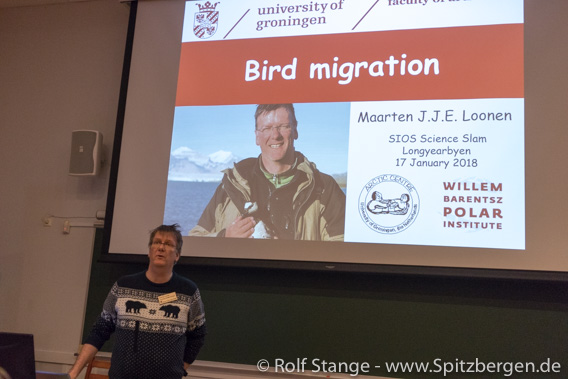
Maarten Loonen talking about arctic migrating birds, mainly geese and their importance for the arctic tundra, in the Svalbardseminar at UNIS.
Finally, my current ceterum censeo: I have made a new photo book, focussing on aerial photography and thus showing the Arctic from a very unsual perspective. In theory, the book is in German, but in practice, it does hardly have text. 134 out of 137 pages do just have stunning photos, placenames and a little map. Norwegens arktischer Norden (2) – Aerial Arctic shows Jan Mayen and Svalbard from the air.
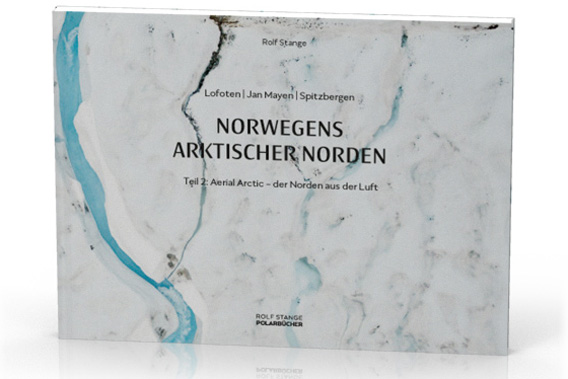
Rolf’s new photo book Norwegens arktischer Norden (2) – Aerial Arctic shows Jan Mayen and Spitsbergen from a new and stunning perspective.
The arctic blog continued: back to Longyearbyen!
Sat
19 Jan
2019
After a winter- and christmas period in our southern home, we return to our northern home: back to Longyearbyen! We spend a few days in Norway on the way up, visiting good friends, before we board the plane in Oslo.
The flight leaves from Oslo Gardermoen in the morning and arrives in Longyearbyen mid-day. We fly away from the sunlight and into the darkness. While climbing up the ladder to the plane, we enjoy a few last moments of sunlight. They will be the last ones for several week.
Gallery flight to Longyearbyen
- gallery anchor link: #gallery_1455
Click on thumbnail to open an enlarged version of the specific photo.
The magic of the polar night is waiting for us!
The moon is waxing – that is not a secret, that is the same everywhere on Earth at the same time. But here, it is more important than elsewhere. Not only because far above the polar circle the moon is hardly seen during the summer, because then it remains largely below the horizon unless it is new moon, when you don’t see it anyway. But now, in winter, the moon is stunning. And it is a very important light source, much more than in latitudes where the sun is more reliable in wintertime.
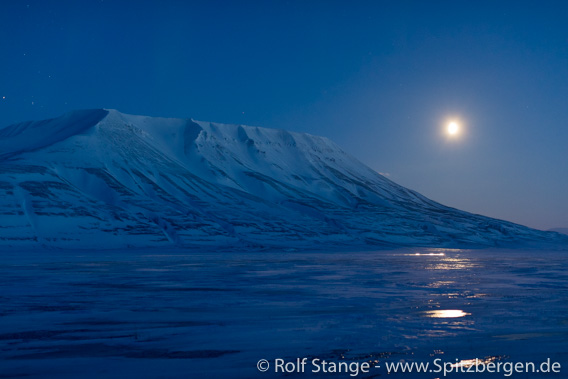
Adventdalen in the polar night (I): the moon is shining over Operafjellet.
The appearance of the country is magical. The moon is casting silver-blue light over the landscape which is covered with a thin layer of snow and ice. On photos, the moon appears very bright so you might even think it is the sun.
Photographing this kind of beauty is a challenge. Most photographs are are far too bright. Of course you can expose your photo until they look as if taken on a sunny day. The results will be beautiful but they don’t have much to do with reality. Reality IS hauntingly beautiful, and it is, well … reality! It doesn’t get much better than that, but it is hard to capture in an image. The beauty that the eye which is accustomed to darkness perceives may just appear as darkness on a reasonably realistic image. And that can also be realistic, but maybe not quite the reality, if that makes sense.

Adventdalen in the polar night (II): a bit darker, a bit more realistic
(? depending on how well your eyes are accustomed to darkness when you are out in the field).
I am trying to find a compromise which is close to reality and delivers the real beauty of the polar night at the same time.
Last but not least for this first entry of my arctic blog 2019 an impression from Longyearbyen in the polar night. A perspective that, I am sure, many of you will know, but possibly in very different light conditions.

High noon in Longyearbyen in polar night. The sundial does currently have some technical problems 😉
Finally, let me mention that I have made a new photo book, focussing on aerial photography and thus showing the Arctic from a very unsual perspective. In theory, the book is in German, but in practice, it does hardly have text. 134 out of 137 pages do just have stunning photos, placenames and a little map.
Norwegens arktischer Norden (2) – Aerial Arctic shows Jan Mayen and Svalbard from the air.

Rolf’s new photo book Norwegens arktischer Norden (2) – Aerial Arctic shows Jan Mayen and Spitsbergen from a new and stunning perspective.
News-Listing live generated at 2025/June/16 at 16:41:38 Uhr (GMT+1)


